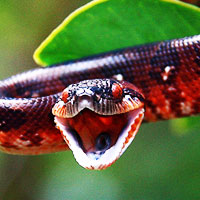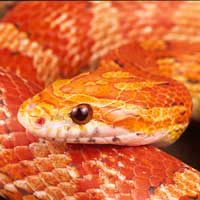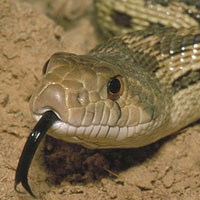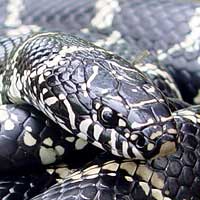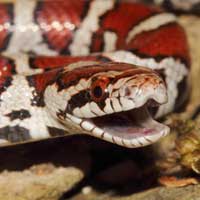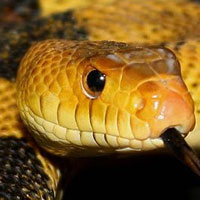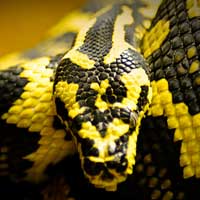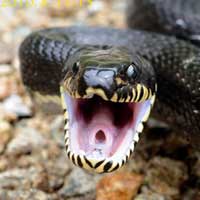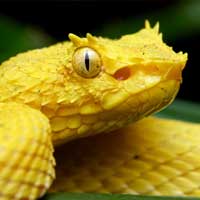Jameson's Mamba: A Complete Guide to the Enigmatic Green Serpent of Africa
Jameson's Mamba belongs to the Elapidae family, which includes other highly venomous snakes such as cobras and coral snakes. Its scientific name is Dendroaspis jamesoni, and it is one of the four species within the Dendroaspis genus, known for their speed, agility, and potent neurotoxic venom.
Scientific Name: Dendroaspis jamesoni
Snake Family: Elapidae
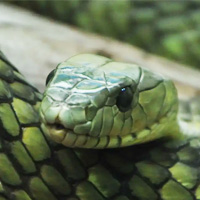
Meet the Elusive and Agile Jameson's Mamba
The Jameson's Mamba (Dendroaspis jamesoni) is a fast, slender, and highly venomous snake native to central and western Africa. Often overshadowed by its more notorious cousin, the Black Mamba, the Jameson's Mamba is equally fascinating and formidable. Its striking green coloration and arboreal lifestyle make it both a beauty and a danger in the reptile world. Though encounters are rare due to its preference for dense forests and swift movements, understanding this species is crucial for enthusiasts and researchers alike. In this article, we’ll take an in-depth look at everything from habitat to care requirements—offering a comprehensive view of one of Africa's lesser-known serpents.
Where Does the Jameson's Mamba Thrive? Understanding Its Natural Habitat
Jameson's Mamba is primarily found in the tropical rainforests and woodlands of Central and West Africa, including countries such as Nigeria, Cameroon, the Democratic Republic of Congo, and Uganda. These snakes prefer regions with dense foliage, high humidity, and ample arboreal coverage, which allows them to utilize their climbing skills and avoid ground-based predators.
As an arboreal species, the Jameson's Mamba is rarely seen on the ground unless in search of prey or water. It spends most of its time navigating tree branches and shrub canopies. Their natural habitat offers the following environmental conditions:
- Humidity levels between 70% to 90%
- Ambient temperatures ranging from 75°F to 88°F
- Elevation range from sea level up to 1,500 meters
- Proximity to rivers or water sources
Deforestation and habitat degradation have begun to impact certain populations, though the species is still considered of least concern by conservation standards. Due to their elusive nature, ongoing studies are needed to fully assess their adaptability in fragmented forests and human-altered landscapes.
What Does the Jameson's Mamba Eat? Insights Into Its Diet and Feeding Behavior
The Jameson's Mamba is a carnivorous predator with a diet consisting primarily of small mammals, birds, and occasionally reptiles. Its diet is typical of a high-level forest predator, requiring fast reflexes, potent venom, and an ability to strike from above in surprise attacks.
They are diurnal hunters, meaning they are most active during daylight hours. Their speed and agility allow them to ambush prey effectively. After delivering a venomous bite, they often release the prey and track it until paralysis sets in—reducing the risk of injury to themselves.
Here is a breakdown of the typical diet:
- Rodents (mice, small rats)
- Birds (nestlings and small species)
- Lizards (occasionally)
In captivity, feeding Jameson's Mamba can be particularly challenging due to their high metabolism and requirement for a live or recently killed diet. Keepers typically offer pre-killed mice or chicks, although replicating natural prey movement can encourage feeding response. Their feeding frequency in captivity ranges from once every 7–10 days, depending on size and age.
Understanding the Jameson's Mamba: Behavior and Temperament in the Wild and Captivity
Jameson's Mamba is often described as shy but highly alert and reactive. In the wild, it prefers flight over fight, disappearing into the trees when disturbed. However, if cornered or provoked, this snake can become extremely defensive and strike with precision and speed.
Key behavioral traits include:
- Arboreal agility: masterful climbers that move swiftly through tree canopies
- Territorial awareness: rarely seen in the open without purpose
- Venomous efficiency: uses neurotoxic venom for both hunting and defense
- Solitary lifestyle: except during mating season, they prefer isolation
In captivity, this species is not recommended for novice handlers. Even seasoned venomous snake experts approach Jameson's Mamba with extreme caution. Their fast and unpredictable movements make them one of the more challenging mamba species to work with in a controlled setting.
How Long Does a Jameson's Mamba Live? Health Factors and Lifespan Insights
In the wild, the average lifespan of the Jameson's Mamba ranges from 10 to 15 years, depending heavily on environmental factors and predation. In captivity, with optimal care, they can live up to 18 years, though this is rare.
Common health issues affecting Jameson's Mambas include:
- Respiratory infections due to improper humidity
- Parasites (internal and external)
- Stress-related anorexia in captivity
- Mouth rot (infectious stomatitis)
Preventative care involves maintaining strict environmental controls and ensuring a low-stress enclosure setup. Routine veterinary exams and careful observation of feeding and behavior patterns are critical. Captive snakes require UVB lighting cycles to simulate natural conditions, though the necessity of UVB for this species remains a debated topic.
Below is a table summarizing their health profile:
| Health Factor | Optimal Condition | Common Issues |
|---|---|---|
| Humidity | 70%–90% | Respiratory illness if too low |
| Temperature | 75°F–88°F | Lethargy or overheating |
| Enclosure Space | Minimum 6’ tall, arboreal setup | Stress from confinement |
The Reproductive Cycle of Jameson's Mamba: Mating, Eggs, and Hatchlings
Jameson's Mamba exhibits a reproductive pattern similar to other elapid snakes. Mating typically occurs during the rainy season, when males become more mobile in search of females. Courtship behavior is relatively understated and may involve the male nudging or aligning with the female’s body.
Once copulation is successful, the female will seek out a warm, secure nesting area, usually within tree hollows or leaf-littered forest floors. She lays a clutch of 6 to 17 eggs, which are left to incubate in the warmth of the environment. There is no parental care post-oviposition.
Egg incubation lasts between 70 to 90 days depending on temperature. Hatchlings emerge fully independent and highly venomous from birth, averaging 12 to 18 inches in length. They begin feeding within the first week of life.
Reproductive fast facts:
- Mating season: Late spring to early summer
- Clutch size: 6–17 eggs
- Incubation period: ~75 days
- Hatchling size: 12–18 inches
Captive breeding is extremely rare due to the dangers involved and the complex environmental triggers required to stimulate reproductive behavior.
Jameson's Mamba in Captivity: Handling, Housing, and Care Essentials
Due to their venomous nature and speed, Jameson's Mamba is not suitable for the average reptile keeper. Only trained professionals with proper licensing and safety protocols should handle or care for this species.
Housing requirements are specific:
- Vertical enclosure at least 6 feet tall
- Secure locks and double-door entry system
- High humidity with misting systems
- Natural branches and hiding areas
Feeding is typically done with tongs through a safe feeding slot. Enclosure cleaning requires the use of hooks and shields, and often a second handler as backup. Lighting cycles should mimic their natural environment—12 hours of light and 12 hours of darkness.
While beautiful and biologically important, Jameson's Mamba is best appreciated in the wild or through professional education facilities. Attempting to keep this species without extensive knowledge and the right infrastructure is not only dangerous but also ethically questionable.
Disclaimer
The information provided in this article is for educational purposes only. SnakeEstate strongly advises against handling or interacting with venomous snakes unless you are a trained and licensed professional. Venomous snakes pose significant risks, and improper handling can result in severe injury or death. Always consult with experts and follow local laws and regulations regarding venomous snake ownership and management.
Other Snakes In This Species
 Asp Viper
Asp Viper Black Mamba
Black Mamba Boomslang
Boomslang Brazilian Coral Snake
Brazilian Coral Snake Bushmaster
Bushmaster Coastal Taipan
Coastal Taipan Common Death Adder
Common Death Adder Common European Adder
Common European Adder Copperhead
Copperhead Coral Snake
Coral Snake Cottonmouth
Cottonmouth Eastern Brown Snake
Eastern Brown Snake Eastern Diamondback Rattlesnake
Eastern Diamondback Rattlesnake Egyptian Cobra
Egyptian Cobra Fer-de-lance
Fer-de-lance Forest Cobra
Forest Cobra Indian Cobra
Indian Cobra Inland Taipan
Inland Taipan Jameson’s Mamba
Jameson’s Mamba King Cobra
King Cobra Lancehead
Lancehead Lataste’s Viper
Lataste’s Viper Malayan Krait
Malayan Krait Mojave Rattlesnake
Mojave Rattlesnake New Guinea Small-eyed Snake
New Guinea Small-eyed Snake Nose-horned Viper
Nose-horned Viper Puff Adder
Puff Adder Russell’s Viper
Russell’s Viper Saw-scaled Viper
Saw-scaled Viper Solomon Island Coral Snake
Solomon Island Coral Snake South American Rattlesnake
South American Rattlesnake Tiger Snake
Tiger Snake Western Diamondback Rattlesnake
Western Diamondback Rattlesnake
